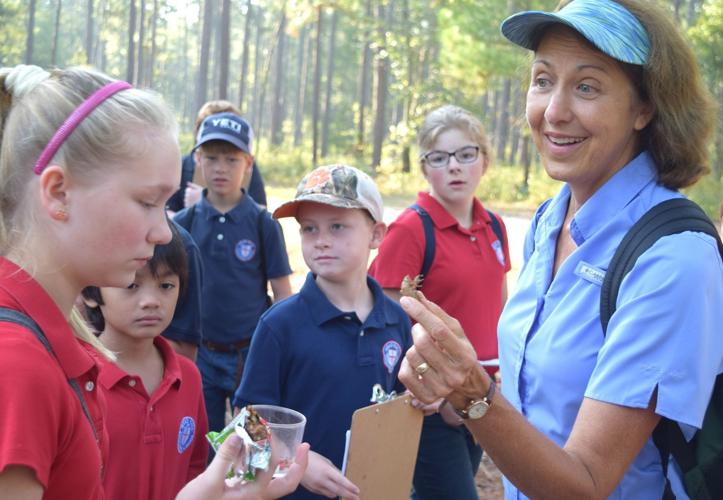Over high hills, through brushy thickets and down sandy trails, students from Mead Hall Episcopal School hiked through the history and natural beauty of Hitchcock Woods on Thursday.
All of the school’s fifth- and sixth-graders explored the woods’ different habitats and looked for evidence of wildlife and prehistoric inhabitants on a guided eco-hike led by Darlene Smalley, Dr. Gary Senn and Mark Roberts of USC Aiken’s Ruth Patrick Science Education Center. The hike was part of the annual Festival of Woods, which celebrates the cultural and natural resources of the woods, a 2,100-acre preserve for equestrians, walkers, joggers and hikers, every fall sponsored by the Hitchcock Woods Foundation.
“Hitchcock Woods is a treasure – to have one of the largest urban forests here right in the center of Aiken,” Smalley said. “We’ve got 70 miles of trails to explore where only walkers and horseback riders are allowed. That’s a special opportunity. It’s important for kids to get out and connect with nature, and Hitchcock Woods is a fantastic place to do that.”
As the students hiked, they learned, stopping frequently to identify whether trees and shrubs were evergreen or deciduous and whether their leaves had smooth edges or were toothy with serrated edges and then recording their findings.
Smalley told the students that Aiken’s white, soft, sandy soil – ubiquitous in the woods – once were dunes beside an ancient ocean and how Alice Algae and her significant other, Freddy Fungus, form a symbiotic relationship to produce lichen, which has properties different from its component organisms.
In the middle of the Ridge Mile Track, Mark Pavlosky Jr. of MPJ Wildlife Consulting explained how the Hitchcock Woods Foundation is working to re-establish colonies of red cockaded woodpeckers in the woods.
In November, 10 of the woodpeckers from the Francis Marion National Forest near Charleston were released in the woods. Eight of them remain, and they hatched three babies this spring, Pavlosky said.
Smalley told the students that the chalk cliffs on the southwestern rim of the Ridge Mile Track might have formed when workers in the early 1800s excavated clay to make level the railroad track for the Best Friend steam engine, which ran nearby. At the time, the railroad, which connected Charleston and the now extinct town of Hamburg near North Augusta, was the longest in the world.
The students also learned about how forestry management practices, such as controlled burning, keep the woods healthy for future students to explore.
After lunch beneath the tall longleaf pines that surround the Horse Show Ring in the heart of Hitchcock Woods, the students conducted an archaeological dig, sifting through sand and looking for pieces of pottery and bits of prehistoric stone blades that Native Americans might have used. They also saw some of the archaeological artifacts, including a blade from a stone axe, a decorative bowl from a smoking pipe and a shard of a dinner plate from the Highland Park Hotel, that other collectors have found in the woods.
At a third station, they shot darts from blowpipes at targets, simulating how Native Americans who lived in the woods might have hunted for food.
Carl Steen, president of the Diachronic Research Foundation, which recently conducted a cultural and archaeological survey of Hitchcock Woods, said the artifacts give the students a broad view of archaeology.
“Through that avenue, we can talk about all of prehistory and the historic periods, as well, because we’ve got historic artifacts here, say, from the Winter Colony in the late 19th and early 20th century,” he said. “Once we’ve shown them the artifacts, we can take them over and show them how they were used at the blowpipe station and, at the dig station, how we recover them in the field.”
Learning from the past can lead to a better future, Steen said.
“These students need to know where they came from, know who was here and know their place on the planet,” he said. “Hopefully, they’ll take a lesson that we’re not the only ones who were ever here and that we need to leave it to our children better.”
Sally Mettlen, a retired educator who grew up riding horses and hiking in Hitchcock Woods and now lives in Beaufort, returned Thursday to volunteer at the archaeological dig station. She said no one word could describe the value of hands-on learning.
“But it’s absolutely fantastic,” she said. “Not only are you providing the students with hands-on experiences, but you’re also educating them about these woods and what has gone on in these woods and that they, when they grow up, have to protect them.”
Christine Rolka, executive director of the Hitchcock Woods Foundation, said the students on Thursday’s eco-hike are the future stewards of the woods.
“Having a special experience like this fosters a connection and an appreciation for this resource,” she said. “The woods for our community is a phenomenal historic and scientific resource, and we’re so fortunate to have the partners that we have. Today’s events are like a marriage of our partners and a celebration of this magnificent resource we have right here in our backyard.”
Barbara Morgan, a member of the Festival of the Woods committee who hiked with the students, said the Hitchcock Woods is more than just a horseback-riding venue.
“They are ecologically important. They are community important – the largest urban forest,” she said. “It’s not just the horse sport that is here – which is fabulous. This is a gift for everyone, and we’re trying to encourage the next generation in understanding the incredible ecology and wonder that are in Hitchcock Woods.”












